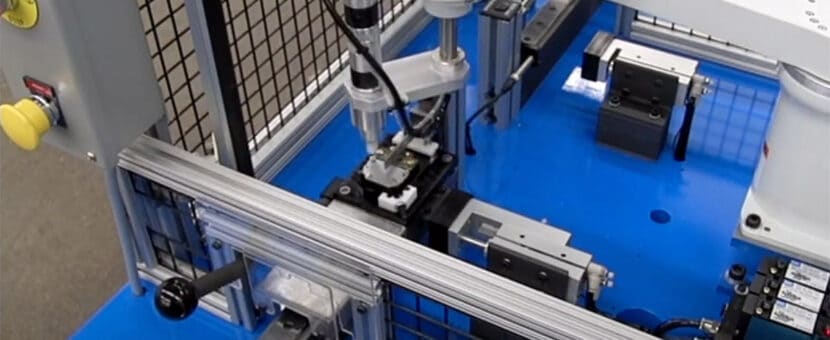The Epson LS3 Robot utilizes a robotic arm to perform assembly tasks, particularly those involving the tightening or fastening of screws, bolts, or other fasteners. It’s configured with a pneumatic screwdriver and programmed to tighten screws in a fixtured part.
This system is designed to allow two separate robotic work areas. Machine operators utilize a slide system to move the fixtured parts in and out of the work areas. Advantages of using a robotic assembly system with a pneumatic screwdriver include:
- Precision and Consistency. Robots can repeatedly tighten screws with high precision and consistency, reducing the risk of over- or under-tightening.
- Speed and Efficiency. Robotic systems can work quickly, improving production throughput and efficiency compared to manual assembly.
- Safety. Automated systems reduce the need for manual labor in potentially repetitive or physically demanding tasks, enhancing workplace safety.
- Custom Assembly. These systems are highly flexible and can be programmed to handle a variety of screw sizes and assembly configurations, making them adaptable to different products and tasks.
Key components of the Epson LS3 robotic assembly system include:
- Robotic Arm. The core of the system is a robotic arm equipped with multiple joints that allow it to move and position itself precisely in three-dimensional space. The arm is programmed to perform specific assembly tasks, such as picking up components, aligning them, and fastening screws.
- End Effector. At the end of the robotic arm, there is an end effector — the part of the robot responsible for interacting with the components being assembled. In this case, the end effector is equipped with a pneumatic screwdriver designed to hold and tighten screws.
- Compressed Air Supply. The pneumatic screwdriver is powered by compressed air, supplied to the screwdriver via hoses or tubes connected to a pneumatic system. When the robotic arm activates the screwdriver, the compressed air is used to drive the screwdriver’s mechanism, creating the necessary torque to tighten or loosen screws.
- Programming and Control. The entire system is controlled by computer programming that specifies the assembly sequence, the positions of components, and the torque settings for the pneumatic screwdriver. The robot’s controller interprets these instructions and coordinates the robot’s movements and screw tightening operations.
You can see our Epson LS3 robotic assembly in action here.
